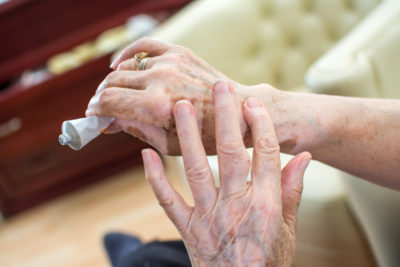Metastatic breast cancer is another term for stage IV breast cancer. It means the cancer has spread to another part of the body, most often the liver, brain, bones, or lungs. This is the most advanced stage of breast cancer. There are over 150,000 women in the United States alone who have metastatic breast cancer, but it’s important to note that it can happen to men, as well.
While metastatic cancer isn’t curable, it is treatable. There are many different treatments available to help slow down the progression of this cancer and help relieve some of the symptoms associated with it, particularly the pain.
Where Can Breast Cancer Spread?
Any cancer that has spread to other areas of the body is referred to by doctors as metastatic. In most cases, the cancer will spread into the bones, lungs, liver, and brain, but it can take years for this to happen. WebMD explains that the cancer is often spread either through the lymph system or bloodstream. The cancer enters the lymph nodes (in this case, axillary lymph nodes, which are located in the armpits), from there it travels into the lymphatic system, a collection of lymph nodes and vessels that are linked to the immune system.
There are tests available for doctors to use to help determine if and where the breast cancer has spread. These tests help your doctor determine what the plan of treatment will be. Even when breast cancer has spread to other areas of the body, such as the lungs, it will still be treated as breast cancer and not for example, lung cancer.
What Are The Most Common Signs and Symptoms of Breast Cancer?
To increase your chances of survival, early detection is vital. One way to detect breast cancer is by knowing the common signs and symptoms and through self-exams and annual check-ups with your doctor.
There are several warning signs to look out for from a lump in the breast to neck stiffness and more. Let’s first take a look at the most common signs and symptoms of breast cancer.
Detection of a Lump
One of the first telltale signs that could indicate you have breast cancer is the detection of a breast lump. It’s important to note that not all breast lumps are cancerous. Benign (non-cancerous) and malignant (cancerous) lumps can develop under the armpit, near lymph nodes, in the collarbone, and around the nipples.
Lumps can feel rigid, hard, or tender. They also don’t typically move when you press against them. To perform a self-breast exam, carefully apply pressure to your breasts and surrounding tissues using your fingers. If you detect a lump, book an appointment with your doctor right away to pursue a diagnosis.
Itchy Breasts
If you develop a rashless itch around your breasts, it may be a sign of breast cancer. Itchy breasts are a common symptom of inflammatory breast cancer.
The itchiness is often accompanied by other symptoms, such as nipple discharge and a change in skin texture (which we’ll get into later). If you develop sudden itchiness in a breast or other accompanying symptoms be sure to talk to your doctor.
Swollen Breasts
Another common symptom of breast cancer is swollen breasts. This can occur due to a breast tumor pressing on the tissues above.
Along with swelling, you may also develop red, patchy, hot skin. The area may also feel very tender to the touch.
Change in Breast Size
If you or your partner notice your breast size is changing, this could be an indicator of breast cancer. This is because the breast tumor can alter the shape or size of the affected breast.
While you check for lumps by performing self-exams, make sure you visually check the size and shape of your breasts in the mirror. Pay attention to the fit of your bra as this can also be an easy way to tell if your breasts are changing size.
Shoulder and Neck Stiffness
Shoulder and neck stiffness can happen from sitting in a poor position and from working out, but these symptoms can also be a sign of breast cancer. If breast cancer is left untreated it can spread to other areas of the body, especially in later stages. These areas include the spine, back, and shoulders.
If you develop shoulder and neck stiffness try a variety of remedies to get relief such as stretching, rest, or a massage. If these fail to ease the stiffness, contact your doctor to find out if breast cancer could be the cause.
Breast Tenderness
Breast tenderness can be the result of a variety of factors, such as a symptom of menstruation but it may also be a sign of breast cancer. Breast tumors can cause pain, however, some individuals may not feel any discomfort at all.
The tumor typically develops in a small, seed-like structure along the breast tissue which can cause your breasts to feel tender when lying down, if they are caressed, or from the friction of a bra.
Nipple Discharge, Sensitivity, and Changes
Breast cancer can develop in the milk ducts that are around the nipple. If this occurs, it can present as a watery, milky, or blood-tinged discharge, which usually causes a scaly crust on the nipple. As a general rule, if you’re not breastfeeding, any discharge from the nipples is not normal.
Another common symptom is nipple sensitivity and nipple changes. First, nipple sensitivity is often caused by breast tumors. Second, changes in the appearance of your nipples can occur if the tumor develops underneath the nipple. Some common indicators are if your nipple becomes inverted, flat, indented, or asymmetrical in shape. If any of these symptoms occur be sure to contact your doctor right away.
Dimpled Breast Tissue
During your self-exams, be sure to pay attention to any changes to your breast tissue. In the early stages of breast cancer, the breast tissue can thicken and feel different from the surrounding tissue.
For example, the skin over your breasts may become dimpled or red. Some individuals describe it as appearing similar to the skin of an orange (peau d’orange).
What Are The Symptoms When Cancer Travels?
The symptoms of metastatic breast cancer can vary depending on the degree of how badly the cancer has spread throughout the body and where the cancer has spread.
Metastasis in the Bone
Breast cancer is able to travel into the bones through the bloodstream. If the cancer has spread to the bone, it will cause severe pain, most commonly back or hip pain. It may also result in too much calcium in the blood (hypercalcemia), swelling, and fragile bones that are easily fractured or broken, as well as a leg or arm that feels weak or numb.
BreastCancer.org notes that, while breast cancer can spread to any bone, it is most often found in the ribs, spine, pelvis, or the long bones of the arms and legs. It also has the ability to travel into the spongy tissue inside the bones called the bone marrow. This is where the blood cells are manufactured by your body.
Metastasis in the Lungs
Because blood has to flow through the lungs to pick up oxygen, they are a common spot for metastatic breast cancer. If breast cancer does spread to the lungs, it likely won’t cause many symptoms. BreastCancer.org says that if it does cause symptoms, they’ll likely include pain, wheezing, shortness of breath, and persistent coughing (sometimes with blood).
Metastasis in the Liver
Cancer cells are able to easily travel into the liver through the bloodstream because the liver is what filters the blood. Metastasis in the liver will likely not cause any symptoms. If there are symptoms, they will likely include pain or discomfort in the abdomen, as well as fatigue, weakness, weight loss, poor appetite, fever, and others.
Metastasis in the Brain
Every cancer has the potential to spread to the brain, but according to WebMD, HER2-positive and triple-negative cancers like metastatic breast cancer are the most likely to spread to this organ. Breast cancer that has spread to the brain will cause symptoms, such as a headache that doesn’t go away, seizures, vision or hearing changes, and sleepiness, as well as the inability to move certain parts of the body. It can also cause memory problems, changes in speech, and behavioral or personality changes.
How Do You Treat Metastatic Breast Cancer?
Chemotherapy
Chemotherapy is the type of treatment most people associate with cancer, and it’s usually the first course of action. Using extremely powerful and potent medication, chemotherapy is used to damage or destroy the cancer cells. It also helps shrink the tumor at a more rapid pace.
While chemotherapy is the most effective treatment for metastatic breast cancer, there are some downsides. The medication can cause side effects, such as feeling extremely fatigued, early menopause, hair loss, nausea, and hot flashes.
Targeted Therapy
Targeted therapy is able to target specific characteristics of cancer cells by using special drugs. The overall goal is to stop these cancer cells from growing. Unlike chemotherapy, this form of treatment is able to specifically target the bad cells and leave the healthy ones alone. For example, BreastCancer.org explains that targeted therapy can attack the protein that allows the cancer cells to grow rapidly or in an abnormal way.
While it’s nice that patients can avoid all the nasty side effects that come with chemotherapy, there are some risks associated with targeted therapy. For example, this type of treatment increases a patient’s chances of developing blood clots and high blood pressure (hypertension).
Radiation Therapy
A patient with metastatic breast cancer may be recommended to undergo radiation therapy if they are experiencing intense symptoms because it will help ease the pain and control the spread of cancer in a specific area. Radiation therapy uses high-energy waves that are designed to kill cancer cells.
As with all cancer treatments, there are some downsides to using radiation therapy. This treatment is able to target specific areas of the body, but patients should expect that some of their healthy cells will also be affected. The body will become exhausted as it tries to rebuild the tissue that is affected. Patients are advised to ensure they are in good health by eating a healthy diet with adequate calories (if not extra calories). Your doctor will provide specific diet instructions.
Prognosis
Survival rates are the highest during the early stages of breast cancer, so early diagnosis and treatment is crucial to the prognosis. That being said, even though a metastatic breast cancer diagnosis is scary, it is treatable. Even without a cure, the best plan of action is to do your own research and get educated on all the treatment options because researchers are working hard every day to come up with new solutions.



